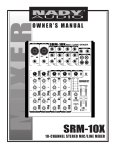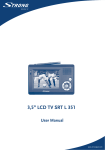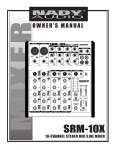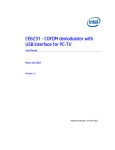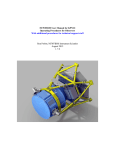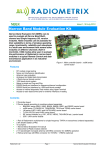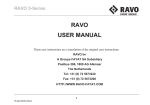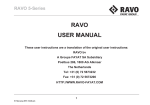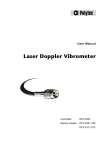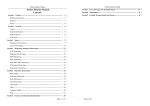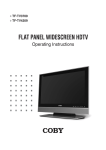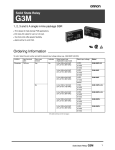Download DWDM Interconnect between UK Licensed Operators
Transcript
NICC Document ND1128:2001/07 ND1128:2001/07 DWDM Interconnect Between UK Licensed Operators INTEROPERABILITY & COMMISSIONING RECOMMENDATION Issue 1 Network Interoperability Consultative Committee Ofcom Riverside House, 2a Southwark Bridge Road, London SE1 9HA UK http://www.nicc.org.uk NICC Document ND1128:2001/07 Normative Information © 2001 Crown Copyright NOTICE OF COPYRIGHT AND LIABILITY Copyright All right, title and interest in this document are owned by the Crown and/or the contributors to the document unless otherwise indicated (where copyright be owned or shared with a third party). Such title and interest is protected by United Kingdom copyright laws and international treaty provisions. The contents of the document are believed to be accurate at the time of publishing, but no representation or warranty is given as to their accuracy, completeness or correctness. You may freely download, copy, store or distribute this document provided it is not modified in any way and it includes this copyright and liability statement. You may not modify the contents of this document. You may produce a derived copyright work based on this document provided that you clearly indicate that it was created by yourself and that it was derived from this document and provided further that you ensure that any risk of confusion with this document is avoided. Liability Whilst every care has been taken in the preparation and publication of this document, NICC, nor any committee acting on behalf of NICC, nor any member of any of those committees, nor the companies they represent, nor any person contributing to the contents of this document (together the “Generators”) accepts liability for any loss, which may arise from reliance on the information contained in this document or any errors or omissions, typographical or otherwise in the contents. Nothing in this document constitutes advice. Nor does the transmission, downloading or sending of this document create any contractual relationship. In particular no licence is granted under any intellectual property right (including trade and service mark rights) save for the above licence to copy, store and distribute this document and to produce derived copyright works. The liability and responsibility for implementations based on this document rests with the implementer, and not with any of the Generators. If you implement any of the contents of this document, you agree to indemnify and hold harmless the Generators in any jurisdiction against any claims and legal proceedings alleging that the use of the contents by you or on your behalf infringes any legal right of any of the Generators or any third party. None of the Generators accepts any liability whatsoever for any direct, indirect or consequential loss or damage arising in any way from any use of or reliance on the contents of this document for any purpose. If you have any comments concerning the accuracy of the contents of this document, please write to: The Technical Secretary, Network Interoperability Consultative Committee, Ofcom, Riverside House, 2a Southwark Bridge Road, London, SE1 9HA, UK. 24/7/01 Issue 1 2 NICC Document ND1128:2001/07 TABLE OF CONTENTS 1. INTRODUCTION 5 1.1 Document History 5 1.2 Normative References 4 1.3 Definitions and Abbreviations 5 1.4 Scope 6 1.5 Purpose 7 2. PRE-REQUISITES 9 2.1 Test Entry Criteria 9 2.2 Test equipment 9 2.3 Safety 10 2.4 Precautions against Electrostatic Discharge (ESP) 10 2.5 Inspection and Cleaning of Optical Connectors 11 2.6 Documentation 12 3. TEST AND COMMISSIONING PROCEDURES 12 3.1 Testing of the interconnect link. 3.1.1 Test options. 3.1.2 Power and path continuity test. 3.1.3 Alarm Tests at Operator A and Operator B Sites 3.1.4 Automatic Laser Shutdown/Power Reduction Test 12 12 12 15 15 3.2 Testing of the traffic paths 3.2.1 Test Options 3.2.2 Error free traffic on STM-16 tributaries 17 17 18 3.3 Stability Test 19 4 TEST EXIT CRITERIA 24/7/01 20 Issue 1 3 NICC Document ND1128:2001/07 5. TEST RESULTS 21 5.1 Test Check List 21 5.2 Test Results Sheets 22 ANNEX A (Informative) Recommended testing prior to commissioning A.1 Test equipment A.2 Essential test requirements A.2.1 Transmit eye mask A.2.2 Spectrum analysis 32 32 32 ANNEX B (Informative) Laser safety – Proposed changes to BS EN 60825-1 35 ANNEX C (Informative) Partially equipped systems 24/7/01 36 Issue 1 4 NICC Document 1. INTRODUCTION 1.1 Document History ND1128:2001/07 Draft A January 2001 (for 17th PNO-TIG DWDM TG meeting 4-1-01). Draft B 9-1-01 Draft C for 19th PNO-TIG meeting 2-5-01 Draft D for agreement by correspondence Draft E for agreement by correspondence (post meeting 5-7-01). Issue 1 24-7-01 1.2 Normative References PNO-TIG DWDM Interconnect Documents: DWDM Interconnect between UK Licensed Operators – Overview Issue 1. – Technical Recommendation Issue 1. PNO-TIG SDH Interconnect Documents: SDH Interconnect between UK Licensed Operators – Overview (version 6). - Technical Recommendation (version 6). - Installation & Commissioning (version 6). British Standards: BS EN 60825: Radiation Safety of Laser Products Part 1:Equipment Classification, Requirements and User Guide (1994). (see annex B). Part 2: Safety of Optical Fibre Communications Systems (2000). Part 4: Laser guards. BS IEC 61340-5-1: Electrostatics. Protection of electronic devices for electrostatic phenomena. General requirements (1998). ITU-T Recommendations: G.664 G.959.1 G.652 G.655 G.957 24/7/01 Optical safety procedures and requirements for optical transport systems (06/99). Optical transport network physical layer Interfaces (02/01). Characteristics of single-mode optical fibre cable (10/00). Characteristics of non-zero dispersion-shifted single-mode optical fibre cable (10/00). Optical interfaces for equipment and systems relating to the SDH (06/99). Issue 1 5 NICC Document ND1128:2001/07 G.707 M.2101.1 Network node interface for the SDH (10/00). Performance limits for bringing into service and maintenance of SDH paths and multiplex sections (04/97). O.151 Error performance measuring equipment operating at the primary rate and above (10/92). 1.3 Definitions and Abbreviations 1.3.1 Interconnection Types For the purposes of this Recommendation the terminology used shall be as follows: In Span Interconnection ( ISI ). In Span Interconnection - occurs when the point of interconnection is located in an optical fibre within a cable duct or cable chamber located between the respective Operators’ premises, where the Network Elements forming the interconnect circuit are located, as shown below: Premises of Operator A Premises of Operator B Point of Interconnect Optical Network Element Optical Network Element Figure 1 In Building Interconnection – ( IBI ) In Building Interconnection - occurs at an optical interface between two network elements within one operators premises, as shown below; 24/7/01 Issue 1 6 NICC Document ND1128:2001/07 Premises of Operator A Premises of Operator B Optical Network Element Optical Network Element Point of Interconnect Figure 2 Note: An optical network element (ONE) is as defined in figure 1 of the Technical Recommendation. 1.3.2 Automatic Safety Mechanisms Automatic Laser Shutdown (ALS) is a mechanism which ensures that a laser transmitter is automatically turned off when a break occurs in the optical fibre into which it is transmitting. Similarly Automatic Power Reduction (APR) may be used in multichannel applications to ensure that the output power of any source(s) is automatically reduced to a lower hazard level. Both mechanisms are described in ITU-T Recommendations G.664. The conditions under which an automatic safety mechanism is mandatory are described in G.664 paragraph 6.1. Note it is not mandatory to provide an automatic safety mechanism for systems of hazard levels 1 to 3A (as currently defined in BS EN 60825), although it is considered useful to do so. The use of automatic safety mechanisms such as ALS or APR is for bi-lateral agreement between operators. 1.4 Scope This test specification encompasses the following: • • • • • • • Essential safety information. The entry criteria for the testing to commence. The order in which testing shall be carried out. The configuration and test method for each test. The mechanism for collection of results. The mechanism for reporting problems. The exit criteria for completion of testing. 24/7/01 Issue 1 7 NICC Document ND1128:2001/07 The configuration of interconnect covered in this document can be defined as an interdomain interface (or IrDI), comprising a multichannel DWDM signal of the following form: P16 S1-1D2. Where : P = pre-OTN 16 = number of optical channels or wavelengths. S = short haul (indicating 11dB span attenuation). First 1 = number of spans in interconnect. Second 1 = NRZ 2.5Gbit/s. D = neither pre, boost, nor line amplifier in circuit. 2 = 1550nm source using G.652 fibre (See companion Technical Recommendation document and ITU-T Recommendation G.959.1. In the first instance the composition of the client signals used over the IrDI and defined in the companion Technical Recommendation document as “digital data streams” shall be SDH operating at the STM-16 rate of 2.488320 Gbit/s . The combination of tests carried out will in general follow the sequence below: At the link level: 1. Power and continuity test. 2. Alarm test. 3. Automatic laser shutdown or power reduction. At the channel level : 1. Error free traffic. In addition a stability test is included (see section 3.3). Some of the tests described in this recommendation may have to be modified or omitted if they are likely to have an adverse effect on live network traffic. Any changes to the testing program should be agreed between the two operators, and service level agreements should be taken into account. If bit error rate tests are carried out, recognition should be given to the principles outlined in ITU-T Recommendation M.2101.1 for STM-16 multiplex sections. Note these tests however are optional at this level and operators may prefer to carry them out during the SDH testing stage (see companion PNO-TIG SDH documents). 1.5 Purpose This document specifies a commissioning procedure for establishing the correct operation of a DWDM interconnect between two independent optical domains (networks), and the 24/7/01 Issue 1 8 NICC Document ND1128:2001/07 operation of circuits carried across that interconnect. The document assumes that the two networks are linked via a single unamplified multichannel span. In-Span Interconnect (ISI), or In-Building Interconnect (IBI) may be used (see section 1.3). The recommendation is applicable both to DWDM interconnects using equipment supplied by a single vendor, and also to DWDM interconnects involving equipment supplied by different vendors. This recommendation does not address the issue of equipment conformance testing. Operators are expected to demonstrate that their equipment is capable of meeting the requirements of the Technical Recommendation (see companion Technical Recommendation document) before undertaking the tests described herein. Where the interconnect is being implemented using equipment supplied by more than one vendor, operators should carry out compatibility testing before undertaking the tests described in this document. Compatibility testing will subsequently be required after hardware, firmware or software upgrades. Conformance and compatibility testing generally requires specialist staff/test equipment. For example transmit eye mask and spectrum analysis tests should be carried out during the conformance and compatibility testing stage. They may also be carried out at the in-station testing stage immediately prior to commissioning. Such tests do not form part of the commissioning procedure described in this document. Essential details of such tests however are given in Annex A. N.B. full in-station test details shall be in accordance with individual operators’/vendors’ internal procedures. 24/7/01 Issue 1 9 NICC Document 2 PRE-REQUISITES 2.1 Test Entry Criteria ND1128:2001/07 • Equipments shall have successfully completed conformance testing. • Interworking between the two network element types providing the interconnect, at the relevant build levels, shall have been proven. • The network elements at each end of the link must have been commissioned in standalone mode in accordance with the respective operator’s internal test procedures. • The equipment should be set to a known state, and any active alarms should be noted. • All necessary fibres and other connections shall have been provided and commissioned in accordance with the respective operators’ internal procedures. • A means of detecting alarm signals shall be available at both ends of the interconnection. • Appropriate company documentation shall be available as described in Section 2.4. • All staff involved in testing shall be trained in accordance with the respective company procedures. • Staff involved in testing shall have access to the appropriate Equipment User Manual(s). • Optical line losses to be agreed and verified. 2.2 Test equipment The following test equipment will be required to enable the tests described in this recommendation to be performed. It would be expected that such test equipment is suitably calibrated and subject to the operator’s internal calibration procedures. • Bit error rate tester (BERT). The tester used must be capable of analysing an STM-16 signal in the optical domain. Test patterns shall conform to ITU-T Recommendation O.151. • Optical Power Meter. • Optical Spectrum Analyser. This instrument must be capable of single channel power measurement within a multichannel signal of 200GHz spaced channels in the C band • Variable Optical Attenuator • Local Terminal with software and appropriate cables. • Appropriate optical patch cords. 2.3 Optical Safety All work on network elements employing lasers shall be conducted in accordance with the respective operators Optical Safety procedures. The following minimum requirements shall apply; 24/7/01 Issue 1 10 NICC Document ND1128:2001/07 BEFORE POWER IS APPLIED TO ANY OPTICAL EQUIPMENT AT EITHER END, PERSONNEL AT EACH END OF THE LINK SHALL CONFIRM TO PERSONNEL AT THE OTHER END THAT THEY ARE READY TO BEGIN TESTING, AND THAT THEY HAVE TAKEN THE NECESSARY PRECAUTIONS. ALL STAFF WORKING ON OPTICAL SYSTEMS MUST BE ADEQUATELY TRAINED. Under normal operating conditions, the optical fibre equipment forms part of a closed system, i.e., the invisible radiation produced is contained within closed paths. However, when the path is broken, (e.g., during testing) exposure to the radiation is possible. The focusing ability of the eye makes it susceptible to damage, and safe working practice must be adopted to minimise the risk of exposure. All optical interconnections should be designed, installed and operated in accordance with the safety requirements detailed in Reference 3 (BS EN 60825 Parts 1 and 2). It is theoretically possible under fault conditions that the level of power emitted by the equipment could exceed the class limit for a brief period. The owner of the transmission equipment who has exclusive access to that equipment should use internal company safety procedures appropriate to the classification of the laser sources. See also section 1.3.2. 2.4 Precautions against Electrostatic Discharge (ESP) Precautions shall be taken in accordance with respective operators’ procedures. The following minimum requirements shall apply; i) All personnel shall wear conductive and bonded wrist straps (which conform to BS IEC 61340-5-1)) and be connected to an electrostatic protection bonding point or, if there is no point available, to a suitable earth point via an ESP adapter. ii) Always connect the ESP wrist strap to the equipment rack ESP bonding point before removing covers, cards or connectors. iii) The ESP wrist strap shall be in contact with the wearer's skin. iv) All test equipment and trolleys should be connected to the ESP bonding point. 2.5 Inspection and Cleaning of Optical Connectors Optical connectors shall be inspected and cleaned in accordance with respective operators procedures. As a minimum the following shall apply; Before any inspection of an optical connector, ensure that the optical power source is removed. Confirm this by the use of an optical power meter to check that no power is present at the connector, before a microscope is used. 24/7/01 Issue 1 11 NICC Document ND1128:2001/07 Note: Inspection and cleaning of optical connectors may have been performed during equipment commissioning. 2.6 Documentation Staff involved in testing should be aware of the following documents in addition to the relevant Health and Safety procedures required by the circumstances: Procedure Ensuring Optical Safety Necessary Documentation BS EN 60825 Parts 1,2 and Internal Company Procedures Protection Against Electrostatic Discharge (ESP) (see also Section 2.3) Internal Company Procedures (see also Section 2.4) Internal Company Procedures Inspection and Cleaning of Optical Connectors (see also Section 2.5) 24/7/01 Issue 1 12 NICC Document ND1128:2001/07 3. TESTING AND COMMISSIONING PROCEDURES 3.1 Testing of the interconnect link. 3.1.1 Test options. This test sequence confirms the operation of the interconnecting DWDM link and terminal equipment ALS/APR and equipment alarms. These tests are designed to ensure that a useable signal on each wavelength is being received at each end of the interconnecting link. Where ALS or APR, is implemented, test sequences 3.1.2, and 3.1.4 should be used. Where ALS or APR is not implemented, test sequences 3.1.2 and 3.1.3 should be used. The test sequences below should be repeated for each interconnect transmit/receive pair in the interconnect network. Likely scenarios are still under discussion but will probably consider the following: • Point to point interconnect using one receive and one transmit fibre only. • 1+1 dual fibre pairs to provide a protected interconnect. • Two separate fibre pairs, forming two sections of an interconnect ring or other network. • A second interconnect pair to provide diversity to an existing interconnect carrying live traffic (Underlying protection will be provided by the SDH layer). The tests will • Give confidence in the end-to-end continuity and quality of the fibre connection (particularly at joints), and the desired signal strength through the fibre. • Ensure distant alarms are reported correctly. • Demonstrate correct operation of ALS or APR (where applicable). • Allow all other tests to be carried out. 24/7/01 Issue 1 13 NICC Document 3.1.2 ND1128:2001/07 Optical Received power and path continuity test. OPERATOR A SITE OPERATOR B SITE Op tic a l sp e c trum MPI-Sa a na lyse r (OSA) Op tic a l MPI-Rb Netw ork Op tic a l Netw ork Element Element MPI-Sb MPI-Ra Figure 3 3.1.2.1 Test Objectives a) To check end to end continuity b) To measure received optical power Note: Before conducting this test details of the correct optical operating range for the receive network elements should be determined from the appropriate equipment handbooks and/or other locally held information. Parameter values for maximum/minimum mean channel output and input powers which are given below must be met in order to comply with the IrDI defined in the companion Technical Recommendation. Note: It may be necessary to wait for the laser to stabilise depending on the vendor specification. 3.1.2.2 Test Summary Optical line continuity is checked by measuring the optical power on each provisioned wavelength (channel) in turn using the optical spectrum analyser. For test purposes the laser power should only be connected to the fibre when the receive end isproperly terminated with either test equipment or DWDM equipment. The test will be conducted for both directions of transmission. The test procedure should be repeated for each optical path when a main and standby interconnect route are implemented. Note: Transmitted optical power will have already been confirmed during equipment stand alone commissioning. 24/7/01 Issue 1 14 NICC Document ND1128:2001/07 3.1.2.3 Test Procedure Steps Actions Operator A to Operator B direction . 1. Operator A records local transmit power at point MPI-Sa for each wavelength in turn (see note above). 2. Operator B records local transmit power at point MPI-Sb for each wavelength in turn (see note above). 3 Operator A disables it’s transmit signal. 4 Operator B connects its Optical Spectrum Analyser at point MPI-Rb. 5 Operator A enables it’s transmit signal and Operator B measures and notes the received power at point MPI-Rb for each wavelength in turn. 6 Operator A disables it’s transmit signal. Operator B reconnects it’s receive fibre to the DWDM equipment. 8 Operator A enables it’s transmit signal. Both operators check that the link is established. Operator B to Operator A direction . 9 Operator B disables it’s transmit signal. 10 Operator A connects its Optical Spectrum Analyser at point MPI-Ra. 11 Operator B enables it’s transmit signal and Operator A measures and notes the received power at point MPI-Ra for each wavelength in turn. 12 Operator B disables it’s transmit signal. 13 Operator A reconnects it’s receive fibre to the DWDM equipment. 14 Operator B enables it’s transmit signal. Both operators check that the link is established. Measurement/Pass Criteria A Tx channel output Power –4/-10dBm B Tx channel output Power –4/-10dBm B Rx channel input Power6/-21dBm 7 Link is operational in both directions. A Rx channel input Power6/-21dBm Link is operational in both directions. Note: blanked out box indicates an instruction to enable the test to be conducted. 24/7/01 Issue 1 15 NICC Document 3.1.3 ND1128:2001/07 Distant Alarm Tests at Operator A and Operator B Sites 3.1.3.1 Test Objective This test confirms end to end alarm signalling between network elements and is applicable to both interconnection types as described in Section 1.3.1. The test is only required if ALS or APR is not used. 3.1.3.2 Test Summary The output of each wavelength (channel) at each end of the link is interrupted and the far end alarm indications noted. 3.1.3.3 Test Procedure Steps 1 2 3 4 3.1.4 Actions Disable each equipped channel (DWDM laser source) in turn at the Operator A end and check that the network element terminating the Operator B end of the interconnecting section reports "Loss of Signal" alarm for that wavelength (channel). Restore the channel output at the A end and establish error free traffic. Disable each equipped channel (DWDM laser source) in turn at the Operator B end and check that the network element terminating the Operator A end of the interconnecting section reports "Loss of Signal" alarm for that wavelength (channel). Restore the network element B output connection and establish error free traffic. Measurements/Pass Criteria LOS alarm present at B end. No System Alarms reported. LOS alarm present at A end. No System Alarms reported. Automatic Laser Shutdown/Power Reduction Test OPERATOR A SITE OPERATOR B SITE MPI-Sa MPI-Rb OPTICAL ATTENUATOR Optical Optical Network Element Network Element MPI-Ra MPI-Sb Figure 4 24/7/01 Issue 1 16 NICC Document ND1128:2001/07 3.1.4.1 Test Objective To demonstrate the correct operation of ALS/APR. This test is applicable to optical interconnections on which an automatic safety mechanism to Recommendation G.664 has been implemented. This test may be applied to either ALS or APR. 3.1.4.2 Test Summary . The optical output in one direction of transmission is broken and correct operation of APR or ALS in the opposite direction monitored. The failed direction is then reactivated and correct recovery from APR or ALS monitored. The test is repeated for both directions of transmission. 3.1.4.3 Test Procedure Steps Actions Measurements/Pass Criteria Operator B to A direction . 1 Using the test configuration in Figure 4 set the optical attenuation to 0 dB and check that the interconnect is operating normally and that no alarms are raised. 2 Increase the optical attenuation such that Loss of Signal alarms are raised at both network elements. 3 Remove the fibre input to Operator A's network element and connect to an optical power meter. Measure the received power. (Test for automatic restart.) Decrease the optical attenuation to 0 dB. Check that the interconnect recovers to normal operation within a period not greater than 300 seconds. Operator A to B direction 5 Using appropriate safety precautions remove the optical attenuator from the Operator A to Operator B transmit direction and fit an optical attenuator in the Operator B to Operator A transmit direction. Normal operation. No alarms. LOS alarm at both ends on each equipped channel. Rx power at input to operator A<50mW. (this corresponds to the class 3A limit in the current version of BS EN 60825) 4 24/7/01 Issue 1 Normal operation and no alarms within 300 seconds. 17 NICC Document 6 7 8 9 ND1128:2001/07 With the optical attenuation set to 0 dB, check that the interconnect is operating normally and that no alarms are raised. Increase the optical attenuation such that Loss of Signal alarms are raised at both network elements Remove the fibre input to Operator B's network element and connect to an optical power meter. Measure the received power. (Test for automatic restart.) Decrease the optical attenuation to 0 dB. Check that the interconnect recovers to normal operation within a period not greater than 300 seconds. Normal operation. No alarms. LOS alarm at both ends on each equipped channel. Rx power at input to operator B < 50 mW. (this corresponds to the class 3A limit in the current version of BS EN 60825). Normal operation and no alarms within 300 seconds. Note: test Process 3.1.2, 3.1.3 and 3.1.4 should be repeated for all interconnect paths. Note: blanked out box indicates an instruction to enable the test to be conducted. 3.2 Testing of the traffic paths 3.2.1 Test options The objective of these tests is to gain confidence in the stability of the set-up including the test equipment by verifying error free traffic flow on each wavelength (channel) when transmitting between Operator A and Operator B. The interconnect will be carrying SDH STM-16 payloads on each optical channel. The need for error rate tests at this stage is for bilateral agreement between operators bearing in mind that similar tests will be carried out at SDH level using the SDH Interconnect&Commissioning procedures described in a companion document (see paragraph 1.2). Possible options are:1. Limited monitoring periods on each channel e.g. 15 minutes no errors. 2. Random channel selection of n out of 16, each monitored for 30 minutes no errors. 3. One channel randomly selected as a sample monitored for 2 hours no errors. 24/7/01 Issue 1 18 NICC Document 3.2.2 ND1128:2001/07 Error free traffic on STM-16 channels OPERATOR A NETWORK Access Point OPERATOR B NETWORK Access Point DWDM Interconnect Optical Network Element Optical Network Element STM16 BERT DWDM Section STM-16 path Figure 5 3.2.2.1 Test Objectives This test is designed to give progressive path confidence prior to subsidiary SDH elements being connected to the DWDM Network element tributaries. This test is optional and for bilateral agreement between operators. 3.2.2.2 Test Summary Test traffic is monitored for error free transmission across the interconnect link on each channel in turn using a Bit Error Rate Tester (BERT) set to 223-1 PRBS NRZ. 3.2.2.3 Test Procedure Steps Actions 1. Internal Test For each operator or contracted installer to internally check/commission the channels of their DWDM equipment. 2 3 4 24/7/01 Measurements/Pass Criteria Start of end-to end Testing For each channel and with the testing arrangement as in Figure 5, set the A end channel under test to loopback, Apply the BER tester to the send and receive of the B end channel. Generate outgoing and monitor incoming traffic. Issue 1 19 NICC Document 5 ND1128:2001/07 Monitor the system for the selected period, checking that there are no errors recorded on the Bit Error Rate Tester and that no alarms are reported by the network elements. Repeat for the other direction of transmission. 6 No errors. No alarms. No errors No alarms Note: blanked out box indicates an instruction to enable the test to be conducted. 3.3 3.3.1 Stability Test Objective The objective of these tests is to ensure that the interconnection path is stable under normal operating conditions. 3.3.2 Test Summary Stability of the optical connectors is tested by percussion testing and overall path stability by means of a period of error free operation. Where protection is employed error free operation of both main and protection path is monitored. 3.3.3 Test Procedure Step 1 2 3a 24/7/01 Action With the testing arrangement as in Figure 5, set the Bit Error Rate Tester to transmit the appropriate pattern for a chosen channel. See Section 3.2.2.2. Carry out a percussion test by gently tapping all fibre connectors at both A & B ends. Check that no alarms are reported, or errors generated. Repeat for the other channels as required. If no protection is employed carry out a 2 hour stability run on the system. Check that there are no alarms reported on the system and that no errors occur in the 24 hours, in either direction of transmission. Issue 1 Measurements/Pass Criteria. No alarms. No errors. No alarms. No errors. 20 NICC Document OR 3b ND1128:2001/07 If protection is employed carry out a stability run of approximately 12 hours with traffic configured on the main path and then not less than 3 hours with traffic configured on the protection path. Check that there are no alarms reported on the system and that no errors occur in the total test period, in either direction of transmission. Note: The detailed arrangements for performing this test will need to be agreed between the two operators. No alarms. No errors. Note: blanked out box indicates an instruction to enable the test to be conducted. 4 TEST EXIT CRITERIA The test exit criteria are as follows: i) ii) iii) All relevant tests have been carried out. All results have been gathered. All problems have been documented and resolved. As each test in this document is performed, the test case on the Test Results Sheet (see section 5.2) must be completed to indicate pass or fail. Deviations from the anticipated results should be noted in the Test Results Comments section for each test on the sheet. A specific test will be deemed to have failed if the result does not comply with the requirements stated in this test specification. A pass may be recorded if after corrective action the result is compliant. Where corrective action is necessary the test shall be repeated and the results noted on a new Test Results Sheet. The details of the corrective action must be recorded on the new Test Results Sheet. Care must be taken to ensure that the corrective action remains valid after any regular maintenance activity, eg replacement of a faulty card. 24/7/01 Issue 1 21 NICC Document 5. ND1128:2001/07 TEST RESULTS 5.1 Test Check List The following lists the series of test described in this Recommendation and provides a means of recording the progress of the interconnect commissioning procedure. The following tests should be carried out:- Interconnect type ALS or APR Standby path implemented Test number to be implemented implemented 1 IBI or ISI X 2 3 4 5 6 7 8 X A X A X A X A X X X X X X X X X X A X X X X X X Test to be implemented Test implemented by mutual agreement if required. Test No 1 Section No 3.1.2 2 3 4 3.1.3 3.1.4 3.1.2 5 3.1.3 6 7 8 3.1.4 3.2.2 3.3 24/7/01 Title Relevant Pass/Fail Optical Received Power and Path Continuity on main path Distant Alarm Test on main path ALS/APR on main path Optical Received Power and Path continuity on standby path Distant Alarm Test on standby path ALS/APR on standby path Error free traffic on channels Stability Yes No Pass Fail Yes No Yes No Yes T No T Pass Fail Pass Fail Pass T Fail T Yes T No T Pass T Fail T Yes T No T Yes T No T Yes T No T Pass T Fail T Pass T Fail T Pass T Fail T Issue 1 22 NICC Document ND1128:2001/07 The relevance of each test will depend upon the interconnect configuration. Details are associated with the test descriptions. 24/7/01 Issue 1 23 NICC Document ND1128:2001/07 5.2 Test Results Sheets The following test results sheets refer to the test cases contained within this document. They can be used to record the results of the tests conducted in accordance with this recommendation. In cases where the procedure is not a measurement, a tick in the Pass/Fail column shall be used to indicate that the activity has been successfully or unsuccessfully carried out. Where tests are conducted from more than one location in each operators network separate Test Results Sheets shall be completed for each site. Test Information Operator A: Operator B: Site A Address: Site B Address: Site A Test Equipment Manufacturer Type Serial Number Optical spectrum analyser STM-16 Bit error rate tester (note 1) Optical power meter Variable optical attenuator Local terminal with software and appropriate cables Appropriate optical patch cords note 1: As appropriate. See Section 2.2. Use blank entry for any other BERT type. 24/7/01 Issue 1 24 NICC Document ND1128:2001/07 Site B Test Equipment Manufacturer Type Serial Number Optical spectrum analyser STM-16 Bit error rate tester (note1) Optical power meter Variable Optical Attenuator Local Terminal with software and appropriate cables Appropriate optical patch cords note 1: As appropriate. See Section 2.2. Use blank entry for any other BERT type. Network Element at Site A Network Element at Site B Optical Network Element Manufacturer Type Serial Number Software Version No. Hardware Version No. 24/7/01 Issue 1 25 NICC Document ND1128:2001/07 Test Results Sheet Test 1 (Described in section 3.1.2) - Optical Received Power and Path Continuity on main path. Operator: Test Engineer: Test Conducted: Step 1 Yes No Measurement dBm 2 dBm 5 dBm 8 11 dBm 14 Test Result: Pass/Fail Pass T Fail T Pass T Fail T Pass Fail Pass Fail Pass Fail Pass Fail Comments Pass Fail Corrective Action: Test Engineer Signature: Date: Operator A Representative: Operator B Representative: 24/7/01 Issue 1 26 NICC Document ND1128:2001/07 Test Results Sheet Test 2 (Described in section 3.1.3) - Distant Alarm Tests at Operator A and Operator B Sites on main path Operator: Test Engineer: Test Conducted: Step 1 2 3 4 Yes No Pass/Fail Comments Pass Fail Pass Fail Pass Fail Pass Fail Test Result: Pass Fail Corrective Actions: Test Engineer Signature: Date: Operator A Representative: Operator B Representative: 24/7/01 Issue 1 27 NICC Document ND1128:2001/07 Test Results Sheet Test 3 (Described in section 3.1.4) – ALS/APR Test on main path Operator: Test Engineer: Test Conducted: Step 1 2 3 4 6 7 8 9 Yes No Pass/Fail Comments Pass Fail Pass Fail Pass Fail Pass Fail Pass Fail Pass Fail Pass Fail Pass Fail Test Result: Pass Fail Corrective Actions: Test Engineer Signature: Date: Operator A Representative: Operator B Representative: 24/7/01 Issue 1 28 NICC Document ND1128:2001/07 Test Results Sheet Test 4 (Described in section 3.1.2) - Optical Received Power and Path Continuity on standby path. Operator: Test Engineer: Test Conducted: Step 1 Yes No Measurement dBm 2 dBm 5 dBm 8 11 dBm 14 Test Result: Pass/Fail Pass T Fail T Pass T Fail T Pass Fail Pass Fail Pass Fail Pass Fail Comments Pass Fail Corrective Action: Test Engineer Signature: Date: Operator A Representative: Operator B Representative: 24/7/01 Issue 1 29 NICC Document ND1128:2001/07 Test Results Sheet Test 5 (Described in section 3.1.3) - Distant Alarm Tests at Operator A and Operator B Sites on standby path Operator: Test Engineer: Test Conducted: Step 1 2 3 4 Yes No Pass/Fail Comments Pass Fail Pass Fail Pass Fail Pass Fail Test Result: Pass Fail Corrective Actions: Test Engineer Signature: Date: Operator A Representative: Operator B Representative: 24/7/01 Issue 1 30 NICC Document ND1128:2001/07 Test Results Sheet Test 6 (Described in section 3.1.4) – ALS/APR Test on standby path Operator: Test Engineer: Test Conducted: Step 1 2 3 4 6 7 8 9 Yes No Pass/Fail Comments Pass Fail Pass Fail Pass Fail Pass Fail Pass Fail Pass Fail Pass Fail Pass Fail Test Result: Pass Fail Corrective Actions: Test Engineer Signature: Date: Operator A Representative: Operator B Representative: 24/7/01 Issue 1 31 NICC Document ND1128:2001/07 Test Results Sheet Test 7 (Described in section 3.2.2) - Error Free Traffic on STM-16 Channels Operator: Test Engineer: Test Conducted: Step 5 6 Yes No Pass/Fail Comments Pass T Fail T Pass Fail Test Result: Pass Fail Corrective Actions: Test Engineer Signature: Date: Operator A Representative: Operator B Representative: 24/7/01 Issue 1 32 NICC Document ND1128:2001/07 Test Results Sheet Test 8 (Described in section 3.3) Stability Operator: Test Engineer: Test Conducted: Step 2 3a OR 3b Yes No Pass/Fail Comments Pass Fail Pass Fail Pass Fail Test Result: Pass Fail Corrective Actions: Test Engineer Signature: Date: Operator A Representative: Operator B Representative: 24/7/01 Issue 1 33 NICC Document ND1128:2001/07 ANNEX A (Informative) Recommended testing prior to commissioning. These tests are intended to demonstrate that DWDM equipment from different vendors will inter-work. A.1 Test Equipment Required Optical Spectrum Analyser – this instrument must be capable of spectrum analysis of a multichannel signal with 200GHz spaced channels anchored to the ITU-T grid in the C band. Oscilloscope – This instrument must be capable of displaying eye patterns against standard masks, (e.g. Figure 2/G.957), for STM-16 NRZ signals. Optical Reference receiver/tunable filter – this instrument must be capable of level adjustment and tunable filtering of individual 200GHz spaced wavelengths (channels) across the C band. A.2 Essential Test Requirements A.2.1 Transmit eye mask (at point MPI-S) A.2.1.1 Test Objective This test is intended to validate the transmitted signal by demonstrating compliance with the eye mask defined in figure 2 of ITU-T Recommendation G.957 (see DWDM Technical Recommendation table 1). A.2.1.2 Test Summary The aggregate (multichannel STM-16 NRZ) signal is accessed at point MPI-S (see Technical Recommendation document figure 1), using a suitable test equipment combination of reference receiver and oscilloscope. The displayed eye mask is verified for compliance with the appropriate values for STM-16 in figure 5 below, on each wavelength (channel) 24/7/01 Issue 1 34 NICC Document ND1128:2001/07 1+y1 Mean level of logical "1" 1 y2 A mp litu 0.5 de y1 Mean level of logical "0" 0 – y1 0 x1 x2 x3 UI x4 1 Time x3 – x2 y1/y2 STM-16 0.2 0.25/0.75 Note: x2 and x3 of the rectangular eye mask need not be equidistant with respect to the vertical axes at 0UI and 1UI. The extent of the deviation is still under study by the ITU. Moreover the parameter Figure 5 The test is repeated for both directions of transmission. 24/7/01 Issue 1 35 NICC Document ND1128:2001/07 A2.2 Spectrum Analysis (at point MPI-S) A.2.2.1 Test Objective. This test is used to validate the transmitted signal by demonstrating compliance with the wavelength grid defined in ITU-T Recommendation G.959.1. A.2.2.2 Test Summary Using an optical spectrum analyser with C Band capability, check on each optical channel in turn and measure the central frequency deviation and channel separation. The deviation should be within +/-40GHz of the nominal frequency shown in the table below and the channel spacing should be at least 200GHz between channel maxima. This should not change over a 24 hour period. Channel No 1 2 3 4 5 6 7 8 9 10 11 12 13 14 15 16 Nominal Frequency Measured deviation Channel spacing THz GHz n/n+1 GHz 192.1 192.3 192.5 192.7 192.9 193.1 193.3 193.5 193.7 193.9 194.1 194.3 194.5 194.7 194.9 195.1 Table 1 24/7/01 Issue 1 36 NICC Document ND1128:2001/07 ANNEX B (Informative) Laser Safety – Proposed Changes to BS EN 60825-1. BS EN 60825-1 (1994) is still current although 2 amendments have been incorporated and a third is due to be published in March 2002. Work started on the revision of this document in 1997. The principal changes affecting telecommunications systems are those being made to the laser classes or hazard levels. It is anticipated that current laser classes 1,2 and 3a will be replaced by new classes 1,1M, 2, 2M. Those lasers currently classified as class 1 or class 2 however will be unaffected. Additionally the power levels associated with these classes are also likely to change. An indication of this is shown below: Wavelength Class/Hazard Level Power limit (approx) 1300nm 1300nm 1550nm 1550nm 1 1M (was 3A) 1 1M (was 3A) 15mW (was 10mW) 50mW (was 22mW) 10mW (unchanged) 150mW(previously 50mW now wavelength dependent). Classes 3B and 4 will be unchanged but some laser and led products currently falling into class 3B will in future be included in classes 1M and 2M. Another new class, 3R covers lasers with accessible emission less than five times the class 2 limit between 400nm and 700nm, or less than five times the class 1 limit at other wavelengths. There is no class 3R for the range 180nm to 302.5nm. 24/7/01 Issue 1 37 NICC Document ND1128:2001/07 ANNEX C Partially equipped systems Where partial equipping of wavelengths (channels) occurs tests should be carried out on those that are equipped in accordance with the procedures outlined in this document. When additional channels are added at a later date test and measurement at the MPI-S, R points in-service is only possible if suitable monitoring points exist. Operators will need to reconcile the inconvenience of planned outages against transponder reliability in such situations. Moreover in some vendor implementations power level adjustment is necessary as additional channels are added. In this situation operators will need to balance the inconvenience of planned outages against the up-front cost of fully equipping from the outset. 24/7/01 Issue 1 38






































